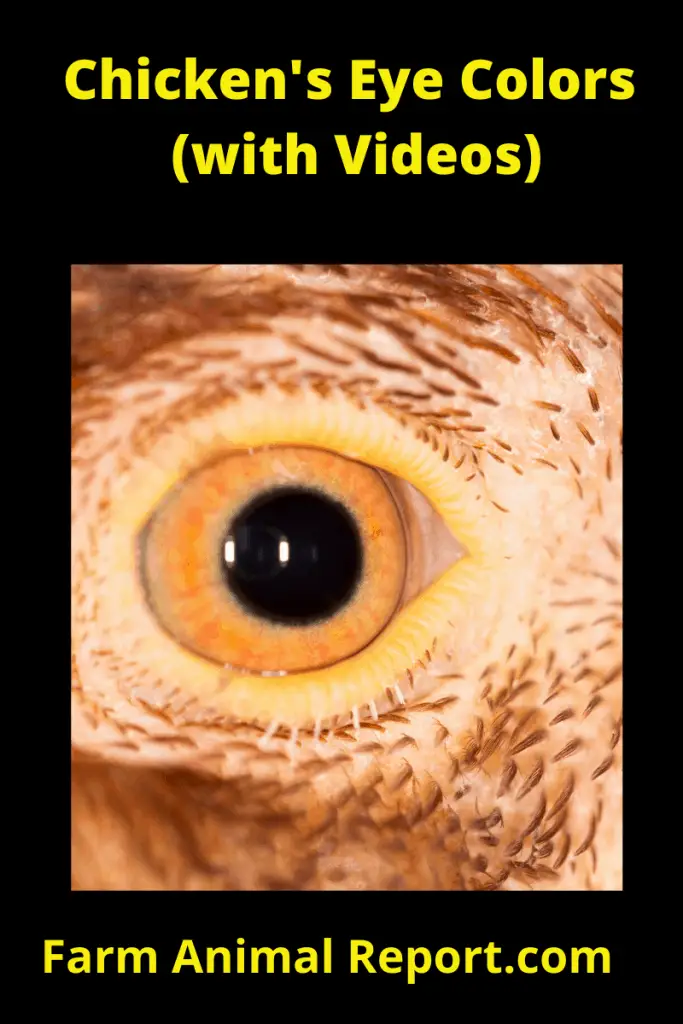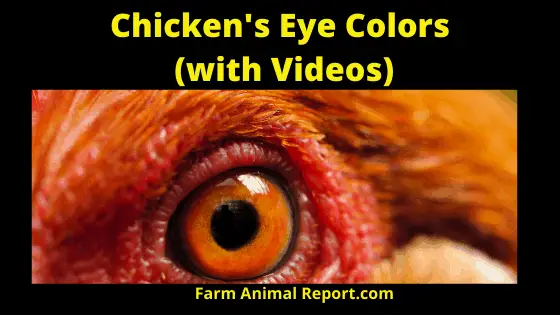Chicken Eye Color?
As a General Rule – There are five eye colors that are commonly found in chickens: gold, red, brown, black & pink (albino). Their eye color is largely determined by genetics, but age, diet & disease can actually affect eye color. three pigments that are responsible for the final gross eye color, melanin, the black pigment, would be considered permanent and non-variable because of inherent qualities, and the carotenoid, or yellow pigment, and the hemoglobin, or red pigment, would be considered variable due to physiological changes.
Some diseases that can cause eye color changes to include cancer (which can turn the color to a grey-green) and Marek’s disease (eyes turn to a cloudy greyish color with the dilated pupil) Chicken Eye Color?
What Colors are Chicken’s Eyes – Eye color, or more specifically, iris color, in the chicken, has become a subject of interest since the pathological “gray eye” has been recognized as a manifestation of lymphomatosis. In attempting to control lymphomatosis by selection, it is probable that there may be discrimination against the apparently normal pale yellow or normal gray-eyed birds.
Check Out Amazon for Educational Resources for Breeding Chickens
This review will attempt to clarify the physiological basis for normal eye color, particularly for the common utility breeds of chickens. It has been pointed out that ocular lymphomatosis, frequently referred to as “iritis,” “pearl eye,” “fish-eye,” “gray eye,” etc., cannot be accurately diagnosed on the basis of color alone, Do Chickens Have Colored Eyes
12 Ways to Make Money by Chicken Farming—Extensive Guidelines for Chicken Farmers
Culling Grey Eye Birds
However, since the poultryman is continually advised to cull all gray-eyed birds, the practical importance of distinguishing between variations in the normal and the pathological condition is readily seen. In order to make this distinction, the pigments which produce eye color and those factors which are known to influence variations in eye color will be described.
Pigments and Their Variations
The American Standard of Perfection lists the eye color for breeds and varieties of chickens. Among the breeds which are most important economically in this country, the reddish-bay eye is listed most frequently, and the brown eye would appear to be second in importance in this respect. Classification of body pigments is as follows:
- Hematogenous
- Cellular (Lipochromes & melanin)
- Metallic
- Rhodopsin
When this classification is applied to the chicken eye, the reddish-bay iris is the result of red (hemoglobin) and yellow (carotenoid) while the brown iris results from the addition of black (melanin) to the two preceding pigments. This discussion will not concern the metallic pigments of other animals nor rhodopsin, a retinal pigment. The pigments of the iris may be classified into two groups;
- The residual or permanent pigments
- The transient or variable pigments.
Of the three pigments which are responsible for the final gross eye color, melanin, the black pigment, would be considered permanent and non-variable because of inherent qualities and the carotenoid, or yellow pigment, and the hemoglobin, or red pigment, would be considered variable due to physiological changes.
Red Pigment Factor
The red component of the gross eye color is due to the superficial vascular rate of the iris. Except in large, healthy males, these vessels are not ordinarily visible by naked eye examination but blend with the surrounding yellow-orange pigment to produce the reddish-bay color.
However, upon close examination with a magnifying device such as an ophthalmoscope, the capillaries may be seen apart from the general mixture of colors. The degree of vascularity or redness is due to variations in the diameter of the blood vessels.
With regard to the prominence of the vascular system of the iris, it seems certain that there are consistent and normal variations among individual birds. Within individuals’ gross variations in redness did not occur but were scored the same quite consistently over an 85-day period.
Yellow Pigment Factor
The yellow to orange hue of the chicken iris is due to carotenoid pigments. In some breeds, the orange color is due to the presence of large numbers of branching connective tissue cells containing yellow or yellow-brown pigment granules, which lie around the capillaries and muscle fibers.
In other breeds of which the Dorking and Orrington are examples, the muscle fibers themselves often contain the yellow pigment granules. In the immature chicken, the muscle fibers alone appear to contain the fat-supported pigment while in adult birds there are fat globules. In hematoxylin and eosin-stained sections, there are mesenchymal-like cells around the anterior vessels and these may be lipophores.
Commonly Eye Colors in Chickens
- Red
- Gold
- Brown
- Black
- Pink – Albino
- Red

Hen’s Eyes
When a hen is in her peak laying years it can wash out the colors from certain areas of her body most notably legs, combs, Seattle, and even her eye color. This condition is known as “Hen’s Eye” Young chicks have very dark eyes up until about 8 weeks of age.
Chickens see in a wider range of colors than humans.
Humans have three cones that allow us to see red, blue & green (with variations & combinations of these colors). Chickens have a fourth cone that allows them to see ultraviolet light and a fifth “double cone” that helps them sense motion.
A mother hen can use the UV cone to literally see which of her chicks are healthiest by seeing the UV light reflected in their growing feathers.
It is also believed they use this UV sight in selecting the healthiest, most colorful mate. Birds can find direction by looking at the sky, seeing the gradation of UV light, and “seeing” which way north is! Their motion sight helps them detect the smallest movements of insects and the presence of predators lurking in the grass.
Because chicken eyes are so sensitive to light & motion, using artificial lighting can lead to grumpiness and bullying because the undetectable (to humans) flickering of a light bulb can drive them crazy. Chickens can use each eye independently to look at & process different things at once.
In addition to upper & lower eyelids, chickens have a third eyelid called a nictitating eyelid that moves horizontally from front to back across the eye. This third eyelid is transparent so they can see through it. You can often see this eyelid when they are dust bathing, they want to be able to see but want to keep dust out of their eyes.
This eyelid has ruined many an otherwise awesome chicken photo! It causes the eye to look hazy in photos when closed (or partially closed)
Chickens have a pineal gland in their brains just under the skull that allows them to sense light even without seeing. The gland regulates their reproductive cycle (so affects egg-laying).
Their skull is thin enough the bright light can penetrate it and stimulate the gland. Even a completely blind chicken can “see” if it is daylight. This is why egg-laying is so dependent on light – they need about 14-16 hours per day of light to stimulate the gland & lay an egg, so most times in short winter days egg production slows way down.
Chicken’s Fovea
Birds (and many mammals) have a structure called a fovea in their retinas that acts as an image enlarger. Chickens have two foveae, one is for distant vision, and one is for close up.
The up-close fovea is oval and sideways, and that’s why when you approach your chicken, they will often bob their heads and tilt their heads sideways to get the image of you into a clearer view. Chickens really can’t recognize flock members until they are within about 24 inches.
Facts about Chicken Vision
Whether in commercial flocks or backyard coops, chickens are endlessly fascinating. While we might never understand what all those quirky head nods mean, we can get a better sense of how chickens see the world with these 10 interesting facts about chicken vision.
- A chicken’s eyes are about 10% of the entire mass of its head.
- Chickens can see 300 degrees around because their eyes are on the sides of their heads.
- Chickens are tetrachromatic. They have 4 types of cones that let them see red, blue, and green light, as well as ultraviolet light. Therefore, they see many more colors and shades than we do.
- Chickens have an additional double-cone structure that helps them to track movement.
- Because their eyes are so sensitive, they can see tiny light fluctuations that are imperceptible to humans. Fluorescent lighting to chickens is like strobe lighting to us, so they often become irritable under these lights.
- Chickens can sense the presence or absence of light through the pineal gland in their head, so even an entirely blind bird can still sense daylight or seasonal change.
- Chickens have a third eyelid called the nictating membrane that slides horizontally over the eye to protect it from dust and debris.
- Chickens can use each eye independently on different tasks simultaneously.
- Chickens have mono-vision. The left eye is far-sighted, and the right is nearsighted. This is the result of turning themselves in the egg so that the right eye is exposed to light through the shell, while the left is not, because it’s directed toward the body.
- Chickens have terrible night vision because they evolved from dinosaurs instead of around dinosaurs, and essentially never spent millennia hiding in the dark.
Chicken / Poultry Breeder Associations
| Rabbit Association | Location | Link |
|---|---|---|
| US Poultry & Egg Association | United States | USPA |
| American Poultry Association | California | APA |
| Ohio Poultry Association | Ohio | OPA |
| National Chicken Council | United States | NCC |
| British Poultry Council | United Kingdom | BPCE |
| Poultry Club of Great Britain | United Kingdom | PCGB |
| Association of Poultry Breeders in EU | Europe | AVEC |
| Australian Chicken Meat Federation Inc | Australia | ACMF |
| Australian Poultry Hub | Australia | Poultry Hub |






